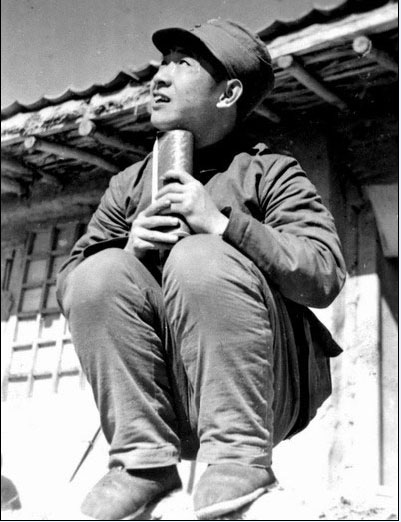|
Great Hall Of The People
The Great Hall of the People is a state building located at the western edge of Tiananmen Square in Beijing. It is used for legislative and ceremonial activities by the government of the People's Republic of China (PRC) and the ruling Chinese Communist Party. The People's Great Hall functions as the meeting place for the full sessions of the National People's Congress (NPC), the Chinese legislature, which occurs every year during March along with the national session of the Chinese People's Political Consultative Conference (CPPCC), a political advisory body. It is also the meeting place of the National Congress of the Chinese Communist Party, which, since the 12th conference in 1982, has occurred once every five years and the party's Central Committee which meets approximately once a year. The Hall is also used for many special events, including national level meetings of various social and political organizations, large anniversary celebrations, as well as the memorial ser ... [...More Info...] [...Related Items...] OR: [Wikipedia] [Google] [Baidu] |
Chongqing
Chongqing ( or ; ; Sichuanese pronunciation: , Standard Mandarin pronunciation: ), alternately romanized as Chungking (), is a municipality in Southwest China. The official abbreviation of the city, "" (), was approved by the State Council on 18 April 1997. This abbreviation is derived from the old name of a part of the Jialing River that runs through Chongqing and feeds into the Yangtze River. Administratively, it is one of the four municipalities under the direct administration of the central government of the People's Republic of China (the other three are Beijing, Shanghai, and Tianjin), and the only such municipality located deep inland. The municipality of Chongqing, roughly the size of Austria, includes the city of Chongqing as well as various discontiguous cities. Due to a classification technicality, Chongqing municipality can claim to be the largest city proper in the worldthough it does not have the world's largest urban area. Chongqing is the only city ... [...More Info...] [...Related Items...] OR: [Wikipedia] [Google] [Baidu] |
Great Leap Forward
The Great Leap Forward (Second Five Year Plan) of the People's Republic of China (PRC) was an economic and social campaign led by the Chinese Communist Party (CCP) from 1958 to 1962. CCP Chairman Mao Zedong launched the campaign to reconstruct the country from an agrarian economy into a communist society through the formation of people's communes. Mao decreed that efforts to multiply grain yields and bring industry to the countryside should be increased. Local officials were fearful of Anti-Rightist Campaigns and they competed to fulfill or over-fulfill quotas which were based on Mao's exaggerated claims, collecting non-existent "surpluses" and leaving farmers to starve to death. Higher officials did not dare to report the economic disaster which was being caused by these policies, and national officials, blaming bad weather for the decline in food output, took little or no action. Millions of people died in China during the Great Leap, with estimates ranging from 15 to 55&n ... [...More Info...] [...Related Items...] OR: [Wikipedia] [Google] [Baidu] |
Tiananmen Square Protests Of 1989
The Tiananmen Square protests, known in Chinese as the June Fourth Incident (), were student-led demonstrations held in Tiananmen Square, Beijing during 1989. In what is known as the Tiananmen Square Massacre, or in Chinese the June Fourth Clearing () or June Fourth Massacre (), troops armed with assault rifles and accompanied by tanks fired at the demonstrators and those trying to block the military's advance into Tiananmen Square. The protests started on 15 April and were forcibly suppressed on 4 June when the government declared martial law and sent the People's Liberation Army to occupy parts of central Beijing. Estimates of the death toll vary from several hundred to several thousand, with thousands more wounded. The popular national movement inspired by the Beijing protests is sometimes called the '89 Democracy Movement () or the Tiananmen Square Incident (). The protests were precipitated by the death of pro-reform Chinese Communist Party (CCP) general secretary H ... [...More Info...] [...Related Items...] OR: [Wikipedia] [Google] [Baidu] |
Hu Yaobang
Hu Yaobang (; 20 November 1915 – 15 April 1989) was a high-ranking official of the People's Republic of China. He held the top office of the Chinese Communist Party (CCP) from 1981 to 1987, first as Chairman from 1981 to 1982, then as General Secretary from 1982 to 1987. Hu joined the CCP in the 1930s, and rose to prominence as a comrade of Deng Xiaoping. During the Cultural Revolution (1966–1976), Hu was purged, recalled, and purged again by Mao Zedong. After Deng rose to power, following the death of Mao Zedong, Hu played a role in the " Boluan Fanzheng" program. Throughout the 1980s, Hu pursued a series of economic and political reforms under the direction of Deng. Hu's political and economic reforms made him the enemy of several powerful Party elders, who opposed free market reforms and Hu's reforms of China's government. When widespread student protests occurred across China in 1987, Hu's political opponents blamed Hu for the disruptions, claiming that Hu's "laxnes ... [...More Info...] [...Related Items...] OR: [Wikipedia] [Google] [Baidu] |
State Funeral
A state funeral is a public funeral ceremony, observing the strict rules of protocol, held to honour people of national significance. State funerals usually include much pomp and ceremony as well as religious overtones and distinctive elements of military tradition. Generally, state funerals are held in order to involve the general public in a national day of mourning after the family of the deceased gives consent. A state funeral will often generate mass publicity from both national and global media outlets. Africa Algeria * Ahmed Ben Bella * Abdelaziz Bouteflika Angola * Agostino Neto * Jose Eduardo dos Santos Botswana * Sir Seretse Khama * Ruth Williams Khama * Gladys Olebile Masire * Sir Ketumile Masire Burundi * Pierre Nkurunziza Cameroon * Marc-Vivien Foe DR Congo * Laurent-Desire Kabila Egypt * Gamal Abdel Nasser (1 October 1970) * Mohammad Reza Pahlavi (29 July 1980), Shah of Iran who died in exile in Egypt * Anwar Sadat (8 October 1981) * Hosni Mubarak ... [...More Info...] [...Related Items...] OR: [Wikipedia] [Google] [Baidu] |
Liu Shaoqi
Liu Shaoqi ( ; 24 November 189812 November 1969) was a Chinese revolutionary, politician, and theorist. He was Chairman of the NPC Standing Committee from 1954 to 1959, First Vice Chairman of the Chinese Communist Party from 1956 to 1966 and Chairman of the People's Republic of China, the ''de jure'' head of state, from 1959 to 1968, during which he implemented policies of economic reconstruction in China. For 15 years, Liu held high positions in Chinese leadership, behind only Chairman Mao Zedong and Premier Zhou Enlai. Originally considered as a successor to Mao, Liu antagonized him in the early 1960s before the Cultural Revolution. From 1966 onward, Liu was criticized and then purged by Mao. In 1968, Liu disappeared from public life and was labelled the "commander of China's bourgeoisie headquarters", China's foremost " capitalist-roader", and a traitor to the revolution. He was purged and imprisoned during the Cultural Revolution, but was posthumously rehabilitated by D ... [...More Info...] [...Related Items...] OR: [Wikipedia] [Google] [Baidu] |
Great Hall Of The People At Night
Great may refer to: Descriptions or measurements * Great, a relative measurement in physical space, see Size * Greatness, being divine, majestic, superior, majestic, or transcendent People * List of people known as "the Great" *Artel Great (born 1981), American actor Other uses * ''Great'' (1975 film), a British animated short about Isambard Kingdom Brunel * ''Great'' (2013 film), a German short film * Great (supermarket), a supermarket in Hong Kong * GReAT, Graph Rewriting and Transformation, a Model Transformation Language * Gang Resistance Education and Training Gang Resistance Education And Training, abbreviated G.R.E.A.T., provides a school-based, police officer instructed program that includes classroom instruction and various learning activities. Their intention is to teach the students to avoid gan ..., or GREAT, a school-based and police officer-instructed program * Global Research and Analysis Team (GReAT), a cybersecurity team at Kaspersky Lab *'' Great!'', a 20 ... [...More Info...] [...Related Items...] OR: [Wikipedia] [Google] [Baidu] |
Richard Nixon's 1972 Visit To China
The 1972 visit by United States President Richard Nixon to the People's Republic of China (PRC) was an important strategic and diplomatic overture that marked the culmination of the Nixon administration's resumption of harmonious relations between the United States and Mainland China after years of diplomatic isolation. The seven-day official visit to three Chinese cities was the first time a U.S. president had visited the PRC; Nixon's arrival in Beijing ended 25 years of no communication or diplomatic ties between the two countries and was the key step in normalizing relations between the U.S. and the PRC. Nixon visited the PRC to gain more leverage over relations with the Soviet Union. The normalization of ties culminated in 1979, when the U.S. established full diplomatic relations with the PRC. When the Chinese Communist Party (CCP) gained power over mainland China in 1949 and the Kuomintang retreated to the island of Taiwan, a former colony of the Empire of Japan ruled fro ... [...More Info...] [...Related Items...] OR: [Wikipedia] [Google] [Baidu] |
Red Star
A red star, five-pointed and filled, is a symbol that has often historically been associated with communist ideology, particularly in combination with the hammer and sickle, but is also used as a purely socialist symbol in the 21st century. It has been widely used in flags, state emblems, monuments, ornaments, and logos. One interpretation sees the five points as representing the five fingers of the worker's hand, as well as the five populated continents (counting the Americas as one). A lesser-known suggestion is that in communist symbolism, the five points on the star were intended to represent the five social groups that would lead Russia to communism: the youth, the military, the industrial labourers, the agricultural workers or peasantry and the intelligentsia. In Soviet heraldry, the red star symbolized the Red Army and military service, as opposed to the hammer and sickle, which symbolized peaceful labour. Different countries across Europe treat the symbol very di ... [...More Info...] [...Related Items...] OR: [Wikipedia] [Google] [Baidu] |
Dais
A dais or daïs ( or , American English also but sometimes considered nonstandard)dais in the Random House Dictionarydais in Oxford Dictionaries Online in the American Heritage DictionaryMerriam-Webster Online - Dais /ref> is a raised platform at the front of a room or hall, usually for one or more speakers or honored guests. Historically, the dais was a part of the [...More Info...] [...Related Items...] OR: [Wikipedia] [Google] [Baidu] |


.jpg)




.png)